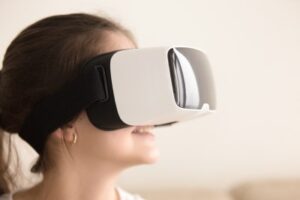Get trained in Automation Engineer Salesforce Dev Salesforce Admin Cyber Security Business Analyst at Wise Quarter
Apple has always been at the forefront of technological innovation, and their latest product, the Apple Vision Pro, is no exception.
This revolutionary device promises to change the way we interact with digital content, blending it seamlessly with the physical world—a concept known as spatial computing.
The future is cinematic. Augmented Reality (AR), once a distant dream, is swiftly becoming a tangible reality. In this tech-o-sphere where various companies are racing towards innovation, Apple is not one to lag.
With the announcement of the Apple Vision Pro, tech enthusiasts and developers are buzzing with excitement.
Understanding what the Apple Vision Pro offers, exploring its unique features, and envisioning its potential can be just as exhilarating.Let’s examine what is curious about Apple Vision Pro.
Table Of Content
1.What does the Apple Vision Pro do?
2.What is Special about Apple Vision Pro?
3.What apps will be on Apple Vision Pro?
4.What programming language does Apple Vision Pro use?
5.How much is the Apple Vision Pro?
6.When can I buy Apple Vision Pro?
7.Can you play games with Apple Vision Pro?
8.Can You Code with Apple Vision Pro?
9.How much will Apple AR glasses cost?
10.Can Apple Vision Pro run IOS apps?
The core of Apple Vision Pro: Programming Language and Framework
· Swift and ARKit
· Machine Learning and Vision
· Cloud Services
The Apple Vision Pro in Your Life
· Work and Productivity
· Health and Fitness
· Entertainment and Creativity
The Apple Vision Pro is essentially a 3D camera that lets you capture spatial photos and videos. It’s designed to blend digital content with your physical surroundings, creating an immersive experience that feels like magic.
The special feature of the Apple Vision Pro is its ability to enable spatial computing. This means that it can overlay digital content onto your physical environment, creating a mixed-reality experience that’s unlike anything else on the market today. It’s like having a window into another dimension, right in your living room.

Although specific apps for the Apple Vision Pro have not been officially announced, it’s safe to assume that it will support a wide range of Apple’s existing apps and services. For instance, Adobe Lightroom has been showcased on the Apple Vision Pro.
While Apple hasn’t revealed the specific programming language used in the Vision Pro, it’s likely that developers will be able to create apps for the device using Swift, Apple’s own programming language.
This would make it easy for developers to create innovative new apps that take full advantage of the Vision Pro’s unique capabilities.
The Apple Vision Pro starts at a price of $3,499, with 256GB of storage.

The Apple Vision Pro was made available in the U.S. starting February 2, 2024.
While Apple hasn’t specifically mentioned gaming, the immersive nature of the Vision Pro makes it an ideal platform for games. Its ability to blend digital content with the physical world could lead to entirely new types of gameplay experiences.
There’s no official word on whether you can code directly on the Vision Pro. However, given its advanced capabilities, it’s likely that developers will be able to use the device to create and test their own spatial computing apps.
The Apple Vision Pro, which can be considered Apple’s version of AR glasses, costs $3,499.
While specific details about app compatibility haven’t been shared by Apple, it’s expected that the Vision Pro will be able to run iOS apps, especially those that have been optimized for spatial computing.

To power the AR experiences on the Vision Pro, Apple will need a robust programming language and framework. The company is well-positioned to leverage its existing tech stack.
It’s safe to assume that Swift, Apple’s in-house language, will play a key role in developing for the Vision Pro. With ARKit as the foundation, developers can harness powerful tools to create smooth, responsive AR experiences.
Machine learning (ML) frameworks like Core ML and Vision are expected to feature heavily, enabling the Vision Pro to recognize objects and scenes in real time. This will be crucial for creating truly augmented experiences that seamlessly integrate with the world around us.
The Vision Pro might likely rely on cloud services for heavy lifting, especially when it comes to processing AI and ML tasks. This would allow for more complex and feature-rich AR apps without compromising on performance.
The Vision Pro will not just be about impressive hardware and sophisticated software. It will be about the experiences it enables, the way it integrates with your life, and the potential it holds for the future.
For professionals, the Vision Pro could open up a new era of AR-based productivity tools, making tasks such as design, collaboration, and remote assistance more intuitive and effective.
The Vision Pro could serve as a personal trainer, guiding you through workouts with unparalleled precision, or it could bring the outdoors in, making daily runs through your living room a reality.
From creating AR-enhanced art pieces to enjoying immersive gaming experiences, the Vision Pro promises to be a versatile platform for entertainment and creativity.
In conclusion, the Apple Vision Pro represents a significant leap forward in technology, promising to change the way we interact with digital content.
With its groundbreaking spatial computing capabilities, it’s set to revolutionize everything from gaming to professional work.